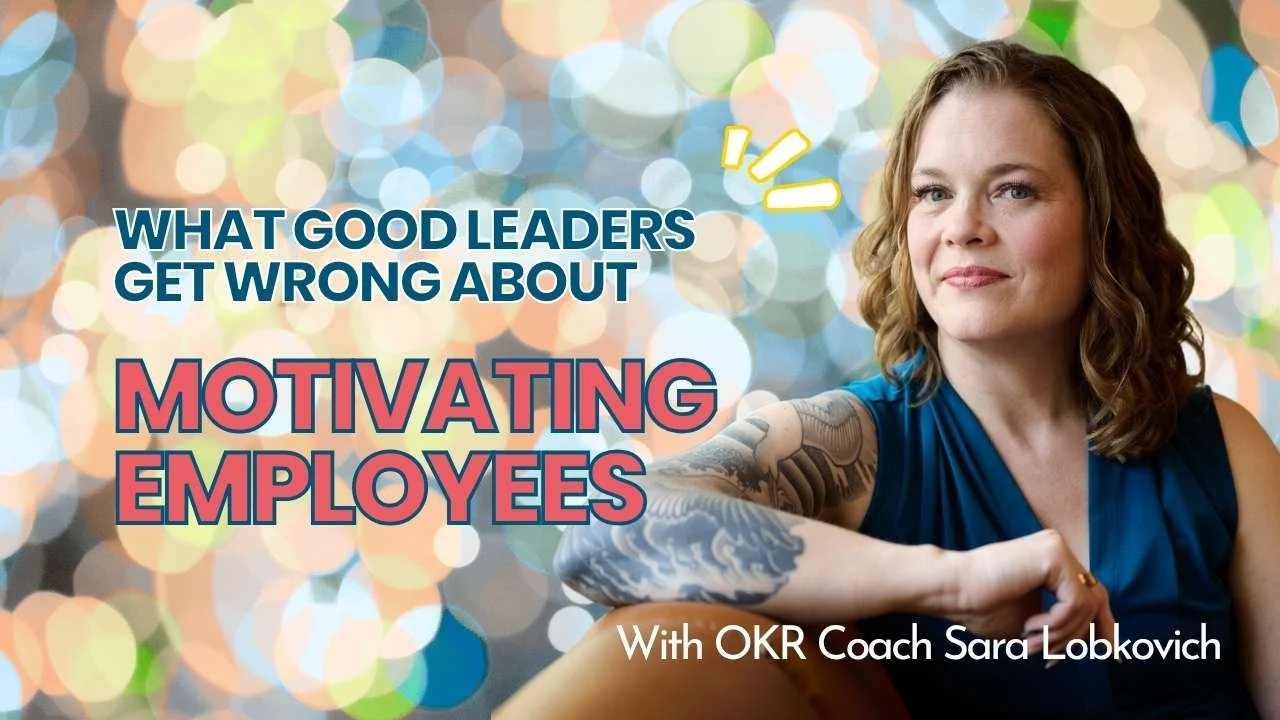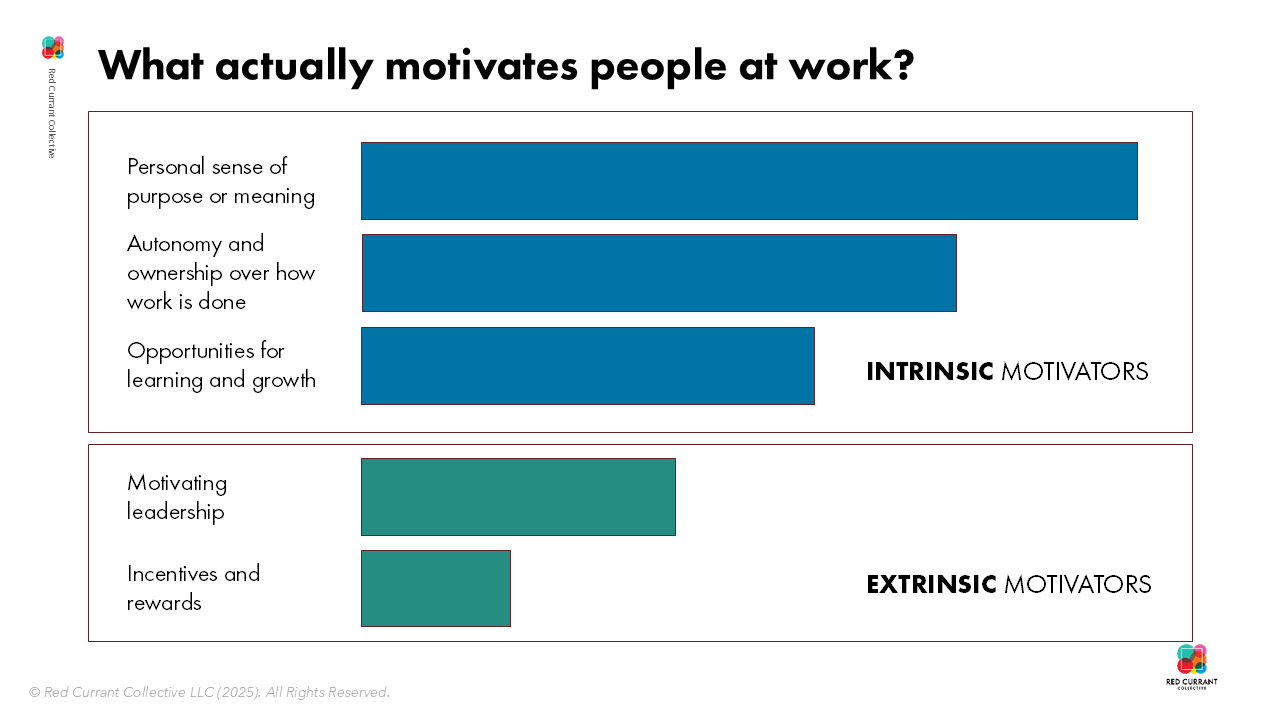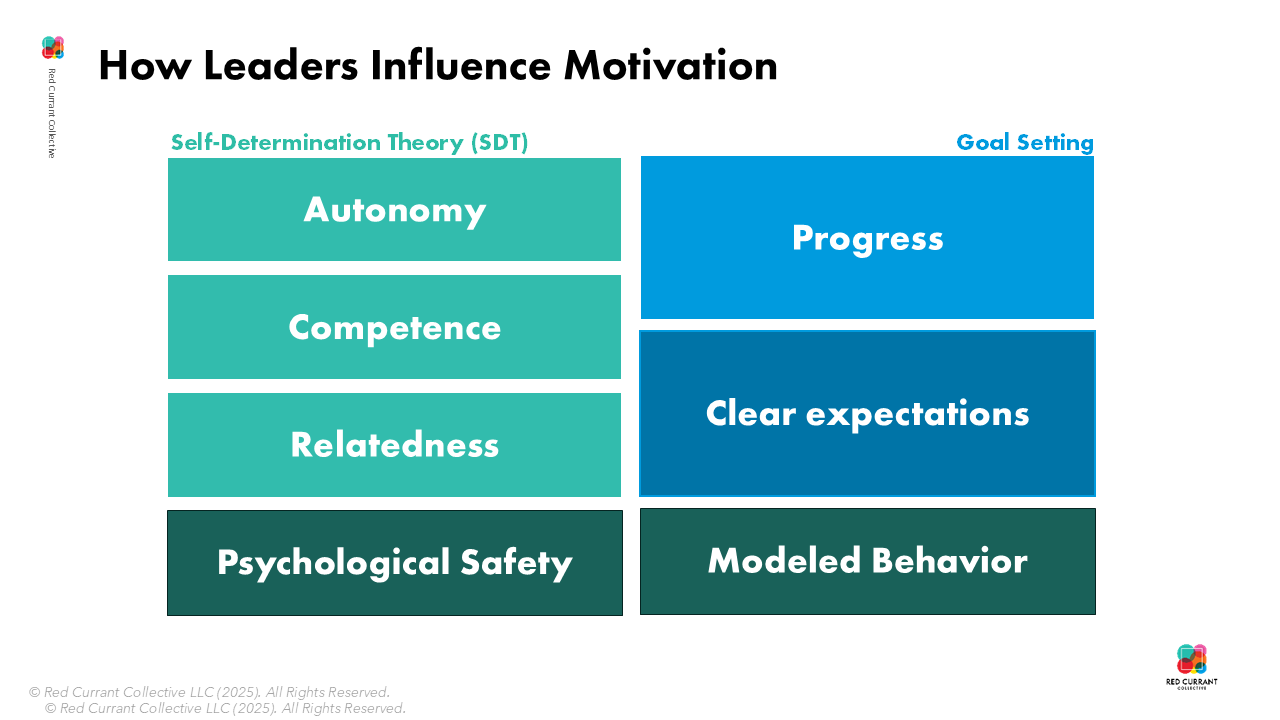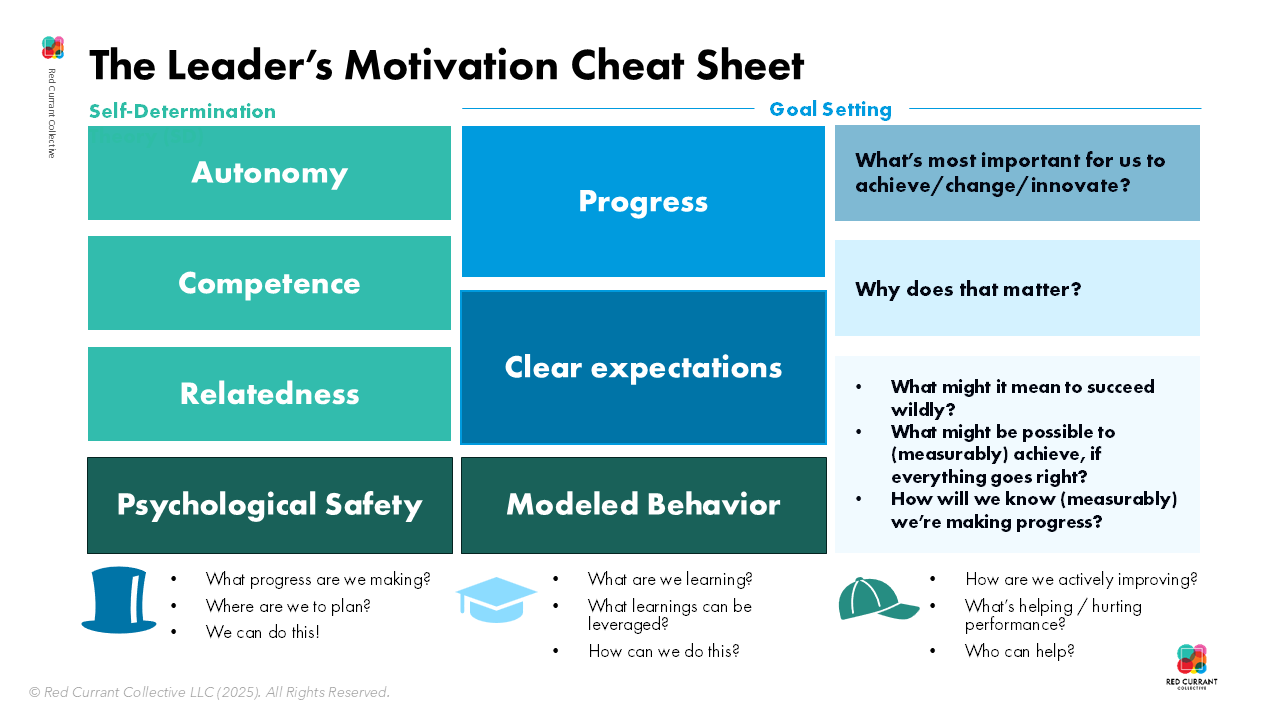How to Motivate Employees: What the Research Shows
…and how leaders get it wrong.
This blog post is adapted from one of my routine speaking topics, which I’d love to share with your organization or team!
Looking for a speaker to help boost your leaders’ motivation toolkit, and build skills for leading for high performance? Check out my speaker information page.
Need a strategy facilitator for you upcoming event? Consider my VIP Executive Strategy Day.
Or, are you planning your own leadership development or leadership team offsite event, and need help making sure it’s successful? Check out my No-BS Executive Strategy Facilitation Guide!
Most leaders default to thinking they need to eliminate employee dissatisfaction to boost motivation.
The truth? Removing dissatisfaction doesn't automatically create motivation.
(And the widely-held belief that stretch goals are "demotivating" if they’re not achieved is not only wrong—it's actively harmful to employee engagement.)
As a nationally board-certified health and wellness coach with decades of executive leadership experience, I've seen how evidence-based motivation science can transform workplace culture. Let me share what actually works to motivate employees, backed by research and real-world results.
The Motivation Crisis in Knowledge Work
Here's the reality: according to Gallup surveys, we're experiencing some of the lowest employee engagement rates since post-pandemic measurements began. On a scale of 0-40, only 31% of employees were engaged as of January 2024.
Yet younger employees desperately want purpose-driven work—86% of Gen Z and 89% of millennials report needing it for job satisfaction and well-being (source: Deloitte’s 2024 Gen-Z and Milennial Survey).
And high engagement isn’t just a “feel good” thing — high employee engagement is good for business (source: Gallup):
70% increase in employee well-being in high-engagement vs. low-engagement workplaces
23% increase in profitability
14-18% productivity boost depending on role
51% lower turnover rates
Motivation is a critical business driver that directly impacts your bottom line.
The Motivation Myths That Are Sabotaging Your Team
Myth #1: Stretch Goals Are Demotivating
This is the most dangerous myth I encounter as an OKR coach. I hear, almost weekly:
"We can't set stretch goals because it's demotivating if we don't achieve them."
The research tells a different story. Locke and Latham's extensive goal-setting research shows that difficult but not impossible goals lead to higher performance than easy or "sandbagged" goals. When we set conservative goals, we tend to achieve those lower targets—not to exceed them.
The data from major OKR platforms reveals a telling pattern: I’ve heard from one platform that organizations see a 19% increase in performance when stretch goals are adopted and then actively managed. More importantly, teams that set stretch goals consistently outperform what they initially thought was possible.
The key qualifier: Stretch goal setting works—assuming a psychologically safe environment. If people face consequences for not exceeding stretch goals, then yes—stretch goals become demotivating. But the problem isn't the goals; it's the environment.
Myth #2: Leaders Must Eliminate Employee Dissatisfaction
Researcher Frederick Herzberg's two-factor theory finds that removing dissatisfaction (what he calls "hygiene factors" like compensation and working conditions) doesn't automatically boost motivation.
You need to balance attention to hygiene factors with focus on true motivator factors: achievement, recognition, meaningful work, and growth opportunities.
Myth #3: It's the Leader's Job to Motivate Their Team
Here's the truth every experienced manager knows but rarely admits:
You can't create motivation in someone else.
Motivation is internal to each person.
What leaders can do is create conditions that help or hurt motivation—removing barriers and supporting the psychological needs that enable intrinsic motivation to flourish.
What Actually Motivates Employees
Some of the research I think about most often, I actually learned about in my Health and Wellness Coach training — but it applies as much to the workplace as it does to health-focused motivation. Self-Determination Theory (SDT), developed by Edward Deci and Richard Ryan, revealed something crucial: extrinsic rewards may actually undermine intrinsic motivation in complex, interesting work.
This explains why traditional carrot-and-stick approaches fail to meaningfully motivate employees in today’s knowledge work environments.
SDT identifies three basic psychological needs that, when met, lead to highest motivation, engagement, and performance:
1. Autonomy
People need to feel control over their actions and choices. This doesn't mean working without guidance—it means having the freedom to self-set inspired, aspirational goals that align with organizational objectives.
In practice, this looks like giving employees input into how they approach their work rather than dictating every step of the process.
2. Competence
Employees need to feel effective and capable in their activities. This happens when people are in the right role at the right time, with appropriate challenges that stretch them without overwhelming them.
Think about this as a person’s "performance-enhancing threshold"—goals that encourage persistence without creating frustration.
3. Relatedness
People need to feel connected to and valued by others. This isn't about forced team-building activities—it's about genuine social support and shared accountability in pursuing meaningful goals.
The Three Questions That Unlock Employee Motivation
After years of working with organizations struggling to engage their teams, I've developed a simple framework based on motivation science that can help. Instead of asking:
"What are we going to do?"
(which focuses on activity — which may or may not be motivating), effective leaders ask three different questions:
Question 1: "What's most important for us to achieve?"
This identifies direction and purpose. It connects individual work to larger organizational outcomes, satisfying that need for meaning that 86% of younger employees crave.
Question 2: "Why does that matter?"
This is where shared purpose emerges. When people understand not just what they're doing but why it matters, shared motivation naturally increases. A compatible “why” helps you tap into each others’ values and sense of impact.
Question 3: "What might be possible if everything went right?"
This is how you set appropriate stretch goals without demotivating people. I think of it as reaching to the very tips of your fingers—excitingly challenging but still within the realm of possibility.
Follow up with: "How will we know objectively that we're making progress?" This creates the clear expectations that reduce anxiety and enable autonomous decision-making.
Want to see a practical way leaders can clearly communicate expectation and manage progress among their teams?
Check out the No-BS Connected Strategy Guide!
A Real-World Example:
A Quarterly Business Review Transformation
Here's a specific example from my client work that illustrates how this plays out in practice.
I worked with an organization where their quarterly OKR reviews had become what I call "watermelon metrics" in action—everything “looked green” on the outside, but there were serious problems—in the red—underneath.
Their Quarterly OKR Review rhythm was a 77-person, 4-hour marathon meeting that had become largely ceremonial. Teams were focused on status reports with what I observed as "subjective spin"—people were reporting green status (subjectively) even when initiatives were actually in trouble.
The collective culture and established behavior led to a high volume of “we’re on track,” or “we’ll get back on track” reporting (based on subjective confidence) — and then two months later, the initiative would fail to deliver its intended outcomes.
What was happening? There was really no reason for people to do anything differently. Leadership was getting information out of the “parade of progress,” and people weren’t incentivized to report anything other than “green,” because there was little real accountability. Nearly all of their key result updates were activity-based rather than outcome-focused, and there were no early warning indicators of actual trouble.
The real cost wasn't just the failed initiatives—it was the erosion of trust, wasted resources, and the opportunity cost of what could have been achieved instead.
After implementing changes (including only including objectively measurable progress and outcome key results — with activities managed via their existing delivery process), after one cycle, the subsequent OKR review featured:
A 75% time reduction (from 4 hours to 1 hour)
60% fewer topics with deeper focus on actual problem-solving
A shift from reporting to problem-solving: instead of status updates, the focus became identifying frictions and removing blockers to progress and achievement
Increased psychological safety—where people felt safe to share real challenges and ask for help
The transformation happened when we separated the "safe to fail" stretch goals from the "must achieve" mandatory goals, and when leadership shifted from evaluating “what got done” to a focus on real progress, outcomes, and removing barriers for their teams.
The Three-Hat Mental Model for Balanced Leadership
Most leaders spend the majority of their time in what I call the "CEO hat"—focused on execution, delivering results, getting things done. This is important, but it's not sufficient for sustained motivation.
The Scientist Hat
This is about experimenting, learning, and accepting that failure is part of the learning process. When leaders model curiosity and treat setbacks as data rather than disasters, they create psychological safety for stretch goal pursuit.
The Athlete Hat
This focuses on improving performance through practice and repetition. Just like athletes fall down repeatedly before winning, employees need permission to iterate and improve without fear of punishment.
The CEO Hat
This is the natural, traditional execution focus—it’s important but shouldn't dominate 100% of your leadership approach.
The key insight: I see leaders default to the CEO hat with minimal scientist and athlete perspectives. High-engagement organizations show more balanced distributions.
Practical Tools: The Three-Level Check-In
Instead of only asking “CEO questions” like "Are we on track?" try incorporating:
Scientist questions:
What are we learning?
Have we had any discoveries we need to implement immediately?
Athlete questions:
How are we actively improving?
What's helping and hurting our performance?
Who can we recruit for support?
Moving from Encouragement to Empowerment
Research on "interrogative self-talk" reveals that questions activate problem-solving pathways more effectively than statements. Instead of saying "We can do this!" try asking "How can we do this?" or "How might we approach this challenge?"
This subtle shift:
Activates intrinsic motivation
Increases sense of control
Generates solutions rather than just positive feelings
Models the curiosity that leads to innovation
Creating the Conditions for Sustained Motivation
Here’s how I think about the impact that leaders can have on employee motivation:
Strong employee motivation rests on a foundation of:
Psychological safety - People must feel safe to share challenges and learn from failures
Modeled behavior - Leaders demonstrate the curiosity, learning mindset, and intrinsic motivation they want to see
The self-determination factors also support motivation:
Autonomy support - Give people input into their goals and approaches
Competence building - Set and support work and learning toward stretch goals with appropriate support
Relatedness fostering - Create genuine connection and shared accountability
And then, a key role of leaders is goal setting:
Clear expectations - Use the three questions framework to create shared understanding
Progress visibility - Regular opportunities to see and celebrate meaningful advancement
The Bottom Line: Motivation Is a Partnership
The organizations that successfully motivate employees understand that motivation isn't something you do to people—it's something you create with them.
Your role as a leader isn't to be the source of motivation. It's to remove barriers, provide clarity, and create conditions where each person's intrinsic motivation can flourish.
Start with one small experiment this week: Ask your team members what truly motivates them from the inside out. You might be surprised by the answers—and by how rarely anyone has asked them that question before.
Work shouldn't hurt. When you align your leadership approach with motivation science, you create environments where people naturally want to do their best work. That's not just good for them—it's transformative for your organization's performance.
Sara Lobkovich is a strategy coach, OKR activist, and nationally board-certified health and wellness coach who has trained over 2,000 OKR coaches across 300+ organizations globally. Her book "You Are A Strategist: Use No-BS OKRs to Get Big Things Done" integrates motivation science with practical strategic achievement frameworks.




